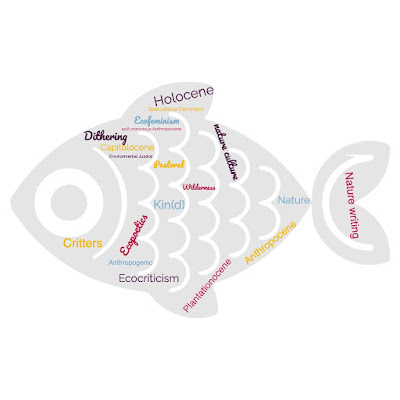For the Class of October 12th - Whitman and Poe
1. For this class, we will continue reading the preface from Walt Whitman's Leaves of Grass (1855) - please, try your hand at reading closely and affectively this excerpt:
pp. 2734-2735: From the paragraph that starts "The art of art" to the end of next paragraph "and makes one"
2. For a poem or excerpt analysis, either in the above prompt or in the following (poems by Edgar Allan Poe), please consider the following guidelines of a close (and affective) reading: pay attention to tone, prosody, semantic networks, significance/effect of rhetoric devices - that is, language - but also, how language makes it thrust at the world and gets entangled with it, for instance: what nature language conceives and how it conceives it?
If you care more for any of the following poems by Edgar A. Poe (the subject of the second half of our class), then try a close analysis of any of the followng:
"The City in the Sea", "The Lake", (in two versions and with Mabbott's commentary), "The Conqueror Worm", "The Bells"
3. Can you relate any of Poe's poems to the supplementary readings (Evelyn Reilly's essay "Environmental Landscapes and Ecopoetical Grief" and / or Emily Alder's "Through Oceans Darkly: Sea Literature and the Nautical Gothic" (in moodle - bibliography section)?






Elizabeth here. Still not sure why I can't post under my name but we can sort that tomorrow I hope. Here's my response to #2.
ReplyDeleteI have almost two separate reactions here that I’m going to try and tie together. Firstly, I’d like to comment on the painting attached above “Christina’s dream” because I’ve seen this painting before; my sister found this picture in a thrift store, and had it hanging in her room for about 5 years. I have looked at this painting countless times, and it always evoked emotion as well as curiosity, and possibly concern, within me. I’d always wondered what drew my sister to this work? Why did she connect to this painting? It felt melancholic. Is this girl escaping or is she returning? Is she hurt? Although, it’s pleasing to the eye, as it’s a professional work, it makes you wonder why this girl is in this field? What is she looking at? What is she feeling? I suppose that’s the beauty of art; we can all interpret the same piece differently. What the artist intends is not always what the audience sees. They can even mislead you. Maybe this painter intended to make us unsure of what was really going on here? Even though we are looking at a girl in a field, there are bigger questions evoked, and so this work becomes a psychological landscape in addition to being a physical landscape. Speaking of psychological settings, I’ll shift over to the works of Edgar Allen Poe, who heavily leaned into the psychological depths of our humanity. He was a writer that inspired many strong reactions to his work. His poems sit in the shadows, creep in the filthy corners, and toil with the more grim aspects of life and death. His work is more intentionally evocative and dark than the painting above, but they share the element of psychological provocation, and possibly a sad nostalgia.
(continued) In Poe’s poem “The City in the Sea” there is also an array of movement and emotion. The tone is overall gloomy but there is a lot of action in the poem. “Up domes — Up spires — up kingly halls” he takes us on a bit of a journey with the use of the words up, down, thrown, sinking, pendulous, breathing (just to name a few). This movement in his words reminds me of a tumultuous ocean, when the waves are unruly and thrashing all about. It’s a poem that represents an example of the Nautical Gothic. There’s no sea monsters but the poem has elements that set a tone of sin, human destruction, death and what remains afterwards in heaven and/or hell. Poe uses end rhymes throughout most of the poem with AABBCC rhyme scheme, giving the flow to the piece an almost playful element “Up many and many a marvelous shrine / Whose wreathed friezes intertwine / The viol, the violet, and the vine.” This last line here is so creative, reusing the same sounding word 3x in a row, as well by first using a man-made musical instrument, then a violet which could symbolize spirituality or innocence, and lastly the vine. The vine that always climbs, and moves, almost like a snake. Again, he creates movements here through his choice of words. Although this poem contains rhyme, flow and movement , it’s tone is overall dark. He is describing the death of a city and civilization that’s now underwater, consumed by the elements, existing in the seawaters, a victim to mankind, to the elements, and to time. Language involving nature is the thread of this poem, as he is using nature to explain the demise of a kingdom. “Around, by lifting winds forgot, / Resignedly beneath the sky / The melancholy waters lie.” He then repeats the use of the word melancholy a little later on: “Resignedly beneath the sky / The melancholy waters lie.” In Emily Alder’s essay “Through Oceans Darkly” she describes “deep water is a useful metaphor for the interiority of the self; the ocean’s precarious surface interfaces between life and death, chaos and order, self and other.” Poe hits these points in this poem, as he writes about the sea, and the lost humanity that exists in form, just beneath the surface of the moody and disorienting ocean. This civilizations story is seemingly trapped forever in the graveyard of the sea, like its imprisoned there in this depth, for eternity. An example of a piece to be filed under the category of: Nautical Gothic. It’s psychological, it’s gloomy, it’s spiritual, and it’s melancholic.
Delete